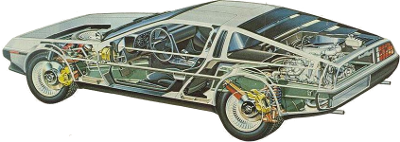Check the following causes, if the cold start takes longer than 3 seconds:
This circuit starts from a blue/yellow wire at the starter. About 5 inches from the starter there is a connection that very often corrodes.
The other end of this connection is at the ballast resistors mounted at the top left of the engine compartment. The voltage from the blue wire from the starter activates the relay that is positioned next to the ballast resistors. When cranking the engine the lower ballast resistor is bypassed by the relay, increasing the voltage available to the ignition coil during cranking.
The common failures in this circuit are the connection near the starter mentioned above, and the relay mentioned above.
A quick check to see if this is the problem is to use a clip lead jumper (i.e. a wire with an alligator clip at either end) to connect the + side of the ignition coil to the battery jump post. Shortcutting the lower resistor is another workaround - just unclip the plugged cable on the right side of the lower resistor and plug it in on the left side. If the car starts with one of these workarounds in place, you need to repair the rest of the circuit. DO NOT leave the workarounds in place for long, it will eventually damage the coil and run down your battery, as this leaves the coil powered all the time.
Zündspule und Widerstand
Bad Thermo-time Switch
The thermo-time switch is located on the drivers side of the water pump. It tells the cold start valve to fire when the engine is cold. When the engine is cold find the plug going to the thermo-time switch and unplug it. Put a jumper wire into the female socket of the black-blue wire going into the plug and, while someone tries starting the engine, touch the wire to ground. If the engine fires up, replace the thermo-time switch.Old Kabels
For my car, a replacement of the cables between all Ignition components made the difference, because the resistance in those cables was just too high (VIN3588, 2020).Bad Starter Battery
A good cold start behavior also depends on a good battery load. If the coldstart is bad for any other reason and you drive short distances, then this will also result in a bad battery load which again has a negative effect to the cold start. Ensure that your battery doesnt lack too much current in standby (key pos 0, radio off, doors closed). In standby, the only voltage consumer should be the clock and the door lock.Ignition Start Boost Circuit
There is a circuit related to the starter that bypasses one of the ignition ballast resistors to compensate for battery voltage "sag" during engine cranking. If that circuit fails, the ignition spark will be weak during cranking and the engine may be hard to start. This can be a problem during cold or hot start conditions. The problem is more prevalent if the battery in the car is old, or the battery/engine ground connections are in poor condition.This circuit starts from a blue/yellow wire at the starter. About 5 inches from the starter there is a connection that very often corrodes.
The other end of this connection is at the ballast resistors mounted at the top left of the engine compartment. The voltage from the blue wire from the starter activates the relay that is positioned next to the ballast resistors. When cranking the engine the lower ballast resistor is bypassed by the relay, increasing the voltage available to the ignition coil during cranking.
The common failures in this circuit are the connection near the starter mentioned above, and the relay mentioned above.
A quick check to see if this is the problem is to use a clip lead jumper (i.e. a wire with an alligator clip at either end) to connect the + side of the ignition coil to the battery jump post. Shortcutting the lower resistor is another workaround - just unclip the plugged cable on the right side of the lower resistor and plug it in on the left side. If the car starts with one of these workarounds in place, you need to repair the rest of the circuit. DO NOT leave the workarounds in place for long, it will eventually damage the coil and run down your battery, as this leaves the coil powered all the time.
Links:
support.delorean.comZündspule und Widerstand
